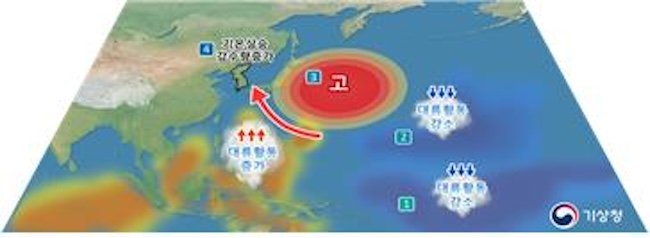
The Korea Meteorological Administration (KMA) announced on September 11 that La Niña conditions are likely to develop this fall, following the dissipation of El Niño last May. (Image courtesy of the Korea Meteorological Administration)
SEOUL, Sept. 13 (Korea Bizwire) – The Korea Meteorological Administration (KMA) announced on September 11 that La Niña conditions are likely to develop this fall, following the dissipation of El Niño last May.
According to the KMA’s analysis of El Niño-Southern Oscillation (ENSO) prediction models, sea surface temperatures in the monitored Pacific regions are gradually decreasing.
This trend suggests a high probability of transitioning to La Niña conditions during the autumn months of September through November.
El Niño is characterized by warmer-than-average sea surface temperatures in the eastern tropical Pacific, while La Niña is marked by cooler-than-average temperatures in the same region.
The KMA defines the onset of either phenomenon when the three-month moving average of sea surface temperatures in the monitored tropical Pacific area deviates by at least 0.5 degrees Celsius from the long-term average for five consecutive months or more.

El Nino and La Nina are complex weather patterns resulting from variations in ocean temperatures in the Equatorial Pacific. (Image courtesy of Flickr/CCL)
The World Meteorological Organization (WMO) corroborated this forecast, estimating a 55% chance of La Niña developing between September and November, with a 45% probability of neutral conditions and a 0% chance of El Niño.
La Niña’s impact on South Korea’s weather varies by season. The KMA reports that during the early autumn, typically from September to early October, temperatures tend to be higher than average with increased precipitation.
This is attributed to the development of a large-scale anticyclonic circulation over the subtropical North Pacific, which enhances the inflow of warm, moist southerly winds into the Korean Peninsula.
However, from November to December, the trend often reverses. The strengthening of cyclonic circulation east of Japan brings northerly winds, resulting in below-average temperatures and decreased rainfall.
The KMA cautions that recent La Niña events have shown increased variability, with some years experiencing warmer temperatures and higher rainfall even in November, underscoring the need for continued monitoring.
Globally, La Niña tends to bring warmer temperatures to Eurasia and North America, while Western Europe and Australia often experience cooler conditions.
Precipitation typically increases significantly in Southeast Asia, Australia, and northern South America, while the southeastern United States sees a decrease in rainfall.
Since 1950, there have been 24 El Niño and 16 La Niña events recorded.
M. H. Lee (mhlee@koreabizwire.com)






